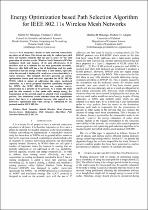 ResearchSpace
ResearchSpace
Energy optimization based path selection algorithm for IEEE 802.11s wireless mesh networks
JavaScript is disabled for your browser. Some features of this site may not work without it.
- ResearchSpace
- →
- Research Publications/Outputs
- →
- Conference Publications
- →
- View Item
| dc.contributor.author |
Mhlanga, Martin M

|
|
| dc.contributor.author |
Olwal, TO

|
|
| dc.contributor.author |
Mutanga, MB

|
|
| dc.contributor.author |
Adigun, MO

|
|
| dc.date.accessioned | 2012-07-04T11:56:32Z | |
| dc.date.available | 2012-07-04T11:56:32Z | |
| dc.date.issued | 2011-09 | |
| dc.identifier.citation | Mhlanga, MM, Olwal, TO, Mutanga, MB and Adigun, MO. Energy optimization based path selection algorithm for IEEE 802.11s wireless mesh networks. IEEE Region 8 Africon 2011 Conference, Livingstone, Zambia, 13-15 September 2011 | en_US |
| dc.identifier.isbn | 978-1-61284-992-8 | |
| dc.identifier.uri | http://ieeexplore.ieee.org/xpls/abs_all.jsp?arnumber=6072125&tag=1 | |
| dc.identifier.uri | http://ieeexplore.ieee.org/application/enterprise/entfilecabinetfull.jsp?ResultStart=0&arnumber=06072125 | |
| dc.identifier.uri | http://ieeexplore.ieee.org/stamp/stamp.jsp?tp=&arnumber=6072125 | |
| dc.identifier.uri | http://hdl.handle.net/10204/5978 | |
| dc.description | Copyright: 2011 IEEE. This is the post-print version of the work. Mhlanga, MM, Olwal, TO, Mutanga, MB and Adigun, MO. Energy optimization based path selection algorithm for IEEE 802.11s wireless mesh networks. IEEE Region 8 Africon 2011 Conference, Livingstone, Zambia, 13-15 September 2011, 6pp | en_US |
| dc.description.abstract | It is everyone’s dream to have network connectivity anywhere at all times. This dream can only be realized provided there are feasible solutions that are put in place for the next generation of wireless works. Wireless Mesh Networks (WMNs) configures itself and because of its cost effectiveness, it is therefore seen as a solution for the next generation networks. However, this field still has a lot of limitations and the main constrain is that the energy of the nodes is very limited, especially when the network is deployed in rural areas where electricity is a scarce resource. This research therefore presents an energy optimization based path selection algorithm for IEEE 802.11s WMNs which is aimed at addressing the above mentioned constrains. As a newly proposed standard specifically designed for WMN, the IEEE 802.11s does not consider energy conservation as a priority in its protocol. As a result, the main goal for this research is that paths with enough energy for transmission in the network must be selected when transmitting packets. Our simulation results obtained from the experiments prove that there is a substantial increase with regard to the network’s operational time when energy is considered by the protocol used in IEEE 802.11s. | en_US |
| dc.language.iso | en | en_US |
| dc.publisher | IEEE | en_US |
| dc.relation.ispartofseries | Workflow;9045 | |
| dc.subject | Wireless Mesh Networks | en_US |
| dc.subject | Hybrid Wireless Mesh Protocol | en_US |
| dc.subject | Energy-Aware | en_US |
| dc.subject | Path Selection Algorithm | en_US |
| dc.subject | Path Selection Metric | en_US |
| dc.subject | IEEE 802.11s | en_US |
| dc.subject | Optimization | en_US |
| dc.title | Energy optimization based path selection algorithm for IEEE 802.11s wireless mesh networks | en_US |
| dc.type | Conference Presentation | en_US |
| dc.identifier.apacitation | Mhlanga, M. M., Olwal, T., Mutanga, M., & Adigun, M. (2011). Energy optimization based path selection algorithm for IEEE 802.11s wireless mesh networks. IEEE. http://hdl.handle.net/10204/5978 | en_ZA |
| dc.identifier.chicagocitation | Mhlanga, Martin M, TO Olwal, MB Mutanga, and MO Adigun. "Energy optimization based path selection algorithm for IEEE 802.11s wireless mesh networks." (2011): http://hdl.handle.net/10204/5978 | en_ZA |
| dc.identifier.vancouvercitation | Mhlanga MM, Olwal T, Mutanga M, Adigun M, Energy optimization based path selection algorithm for IEEE 802.11s wireless mesh networks; IEEE; 2011. http://hdl.handle.net/10204/5978 . | en_ZA |
| dc.identifier.ris | TY - Conference Presentation AU - Mhlanga, Martin M AU - Olwal, TO AU - Mutanga, MB AU - Adigun, MO AB - It is everyone’s dream to have network connectivity anywhere at all times. This dream can only be realized provided there are feasible solutions that are put in place for the next generation of wireless works. Wireless Mesh Networks (WMNs) configures itself and because of its cost effectiveness, it is therefore seen as a solution for the next generation networks. However, this field still has a lot of limitations and the main constrain is that the energy of the nodes is very limited, especially when the network is deployed in rural areas where electricity is a scarce resource. This research therefore presents an energy optimization based path selection algorithm for IEEE 802.11s WMNs which is aimed at addressing the above mentioned constrains. As a newly proposed standard specifically designed for WMN, the IEEE 802.11s does not consider energy conservation as a priority in its protocol. As a result, the main goal for this research is that paths with enough energy for transmission in the network must be selected when transmitting packets. Our simulation results obtained from the experiments prove that there is a substantial increase with regard to the network’s operational time when energy is considered by the protocol used in IEEE 802.11s. DA - 2011-09 DB - ResearchSpace DP - CSIR KW - Wireless Mesh Networks KW - Hybrid Wireless Mesh Protocol KW - Energy-Aware KW - Path Selection Algorithm KW - Path Selection Metric KW - IEEE 802.11s KW - Optimization LK - https://researchspace.csir.co.za PY - 2011 SM - 978-1-61284-992-8 T1 - Energy optimization based path selection algorithm for IEEE 802.11s wireless mesh networks TI - Energy optimization based path selection algorithm for IEEE 802.11s wireless mesh networks UR - http://hdl.handle.net/10204/5978 ER - | en_ZA |





